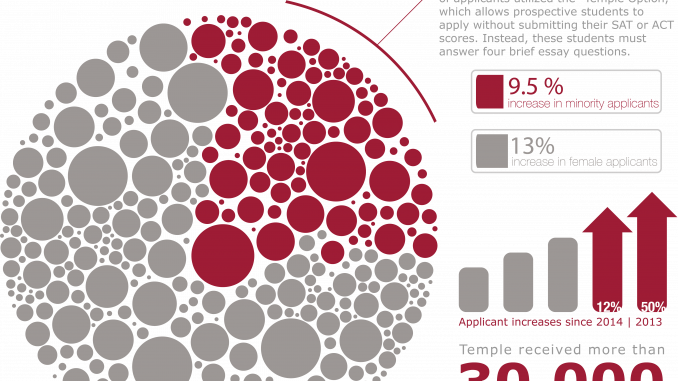

When Temple administration introduced the “Temple Option” last year, the primary goal was not to increase minority applicants.
That was the name given to a university admissions initiative allowing prospective students to apply without submitting SAT or ACT scores. Students who decide not to submit scores must instead answer four brief essay questions.
The “Temple Option” was initiated, in part, because studies showed students from higher-income families scored higher on standardized tests. Black said the university wanted to find those students who succeeded in high school but fared poorly on the SAT or ACT. Many of those students were first-generation college students or minorities, he said.
The introduction of the “Temple Option” likely influenced the increase in applications from minority students and a school record in total applications, Black said.
“Of those students who applied [using] ‘Temple Option,’ the big shift in application behavior came from students of color and women,” Black said.
Temple received more than 30,000 applications for the first time in its history for the academic year, starting in Fall 2015. This total represents a 12 percent increase over last year and around a 50 percent increase from two years ago.
Of that 30,000, 24 percent opted not to submit scores.
There has been a steady increase in the number of minority students applying to Temple. Information on minority enrollment wasn’t yet available, but Black had information on the application pool.
The number of students of minority backgrounds applying to Temple has increased about 9.5 percent from last year and about 20 percent more than the Fall 2012 semester. The number of female applicants has risen 13 percent.
“So you can see we have a steady increase,” Black said. “And we’ve done a lot of work—not only in the Philadelphia area, but out of state—New Jersey, New York, Maryland. We’re even out in California now.”
Black said part of Temple’s mission is generating “access,” which creates a culture of diversity.
“‘Access’ generally means students who are first generation [college students] and often times minority, underrepresented students,” he added.
“Throughout the recruiting year, when I talk with families and particularly [at] our open houses before they are applying, the level of relief that came across the people is immediate when they found out that they didn’t have to submit their test scores,” Black said.
Black believes the real test will be when the university studies how those students who utilized the “Temple Option” stack up to students who used the standard application process once the school year begins.
The four essay questions search for different attributes.
“How do they progress through their four years here?” Black said.
“What our essay is looking are other strengths, different strengths,” Black added. “How self-aware are the students? Do they have a sense of self-authorship? How do they cope with failure? How do they explain their successes or their failures?”
“We’re looking for those kinds of motivational developmental strengths,” he added.
Jack Tomczuk can be reached at jack.tomczuk@temple.edu or on Twitter @JackTomczuk.


Be the first to comment